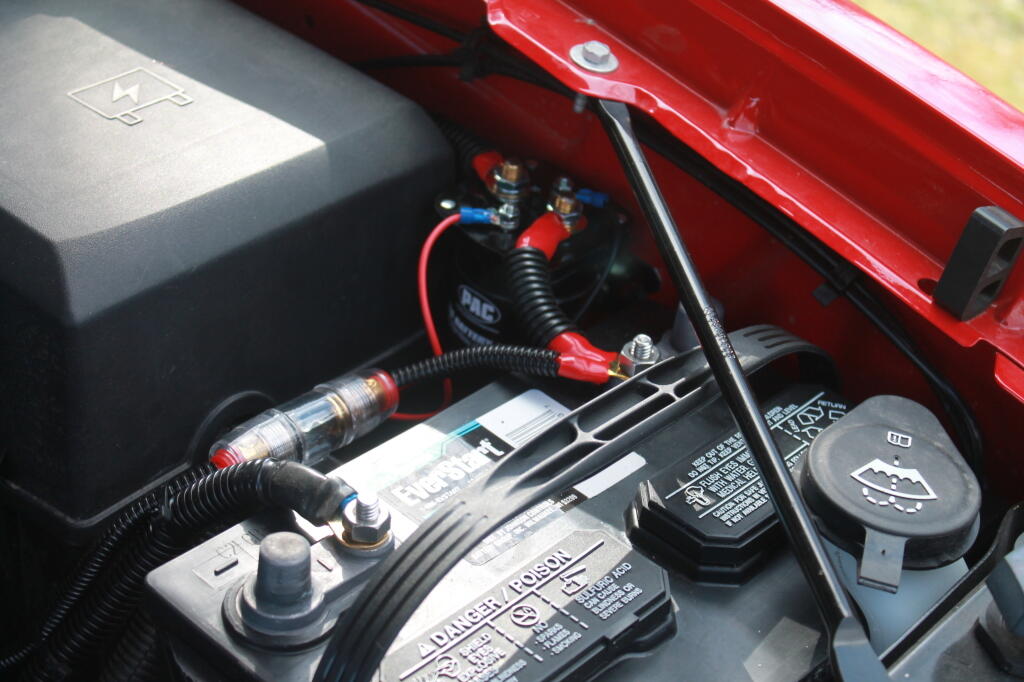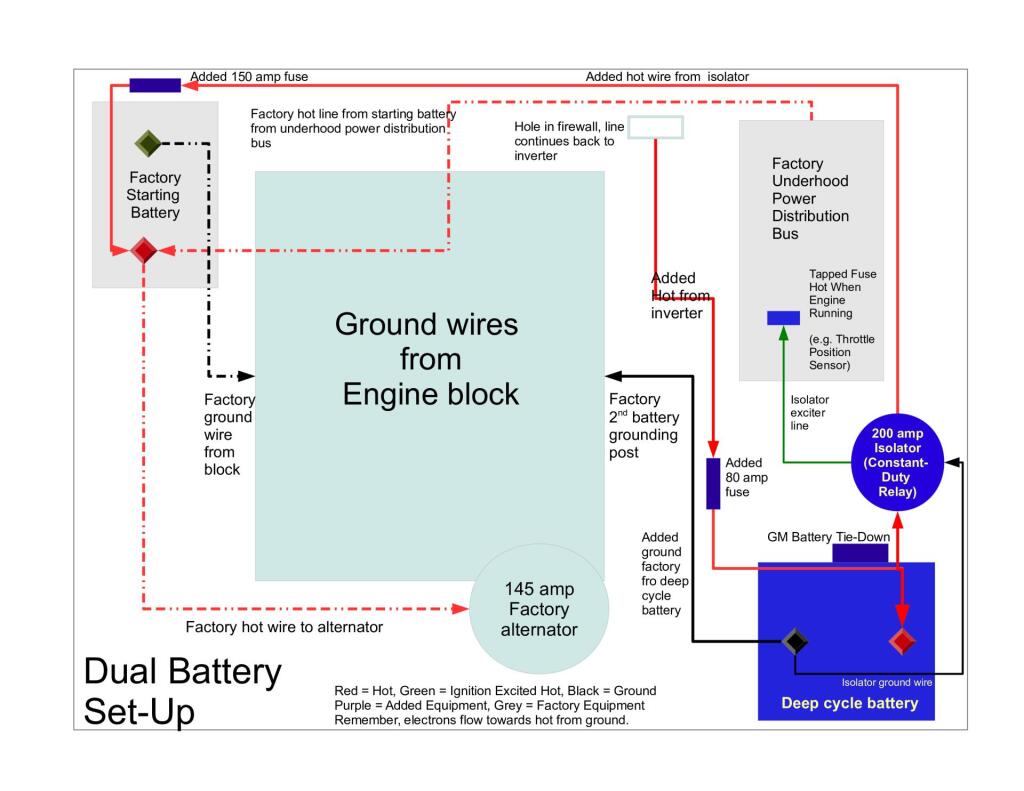Solar power is up and running on my truck’s camper shell. Accessory battery is charging at 14.5 volts all while the engine is shut off. Probably the battery will be fully charged soon and the solar controller will just be floating the charge. Everything is nice and tight, no rattles while driving, looks fairly neat. I think I did a nice job. Me happy.
Solar Project
May 17, 2018 8:21 pm Update
Solar panel mounted on my truck, but I still need to run the wires and hook up the fuse. I estimate it will do about 4 amps in bright sun or about 50% output due to lack of a perfect angle. The panel is 100 watt or 8.5 amp but we don’t have that kind of sunshine outside of laboratory.
Unless it’s a bright sunny day, parked in the sun all I probably won’t be able to get the accessory battery to full charge this way, but combined with the alternator running while driving, I should easily be able to get close to 100% most days camping after a 15-30 minute drive plus a few hours parked in the sun.
Can a 100 watt solar panel beat an occasionally run 150 amp alternator ?
A 100-watt solar panel in theory can put 7.35 amps at 13.6 volts. In contrast, an 150 amp alternator, run at highway speeds can in theory put out 150 amps at 13.6 volts. Except that 150 amp alternator will put out nearly half as much electricity at idle or maybe 70 amps due to the engine running at half it’s highway speed, and that’s before the regular electrical loads of an engine’s computer and headlights take their bite out of power supply.
When I camp, I usually use my deep cycle battery mounted under my truck’s hood to power my campsite, radio, and other equipment. It works fairly well, but after a while, it becomes discharged and I need to start the truck’s engine to charge it back up for 10 minutes when I hear the low battery alarm or the truck’s computer notices a low battery. I probably have to do this once every 1.5 to 2 hours. This keeps the battery fairly healthy, but it’s still not as strong as when I first arrived at the campsite, after often hours of charging at the maximum necessary charge provided by the alternator.
Energy Math
Amps are the amount of current Voltage is with how much force the current is moving, e.g. 13.6 watts Wattage is amount of work consumed, e.g. 12 watt LED bulb Amp Hours are the number of amps consumed per hour Watt Hours are the number of watts consumed per hour Amp = Wattage / Voltage
The Truck’s Charging At Idle
Alternator Peak Output – 150 amp Typical Output at Idle (possibly lower after predatory loads) – 70 amp Voltage – 13.6 volts Charging Hours – 10 minutes every 1.5 hours = 0.11 hour charging Amp Hours Charged (over 1.5 hours) – 7.7 amp/hr Watt Hours Charged (over 1.5 hours) – 105 watt/hr Watt Hour Charged per 10 hour day (assuming I start the truck every 1.5 hours during 10 hours) – 0.7 kW/hr
100 watt solar cell
Solar Cell Output – 7.35 amp Realistic Solar Output – 5.1 amp (70% of maximum on sunny day) Voltage – 13.6 volts Charging Hours – 1.5 hour Amp Hours Charged (over 1.5 hours) – 7.7 amp/hr Watt Hours Charged (over 1.5 hours) – 105 watt/hr Watt Hour Charged per 10 hour day – 0.7 kW/hr
A 100-watt solar panel which operates all day when the sun is it on will produce more energy than an alternator running only occasionally.
Solar camping preliminary graphics
I currently have a deep-cycle, second battery under the hood of my truck. It is connected to an 800-watt inverter under the back-seat of my truck.
For days when I expect to be camping at a campsite for multiple days without moving the truck, I want to be able to provide the truck with solar power to charge the deep-cycle battery during the daytime and operate low-wattage appliances like an alarm clock, an AM/FM radio, and a CB Radio – and not have to start up the truck every couple of hours. If I plan to go out hiking, hunting, or fishing in the evening, it would be nice to be able to leave a light on campsite and know my battery wouldn’t start to discharge until close to dark.
I think a realistic estimate to power produced would be:
- 50-70 watt/hour on a sunny day
- 0.5-0.7 kW/hr for a 10-hour day
- 20-40 watt/hour on a cloudy/drizzle day or with moderate shade
- 0.2-0.4 kW/hr for a 10-hour day
Compared to the 2.2-3.2 kW/hr daily that I use in my apartment that is not a lot of electricity. But I am not planning running a refrigerator, electric hot water heater, or a electric stove on it. I also can just crank the truck up when I need more power from the alternator at night when I need more juice to keep the lights on.
Add solar power to your truck camper by Jeffrey Yago, P.E., CEM
A nice basic set up, although I don't want to mount my panel to my truck roof as I often park where it's shady and cool when camping in the summer.
Started looking at solar power for camping
For some time now, I’ve wanted to learn more about solar electricity. I have read books on it and know how it works in principal, but I have basically no first hand experience as it comes to solar power. At the same time, my electrical load is growing on my truck when camping, especially once I install the CB radio installed in my truck.
 Why I Am Thinking Of Going Solar
Why I Am Thinking Of Going Solar
I hate having to turn on the truck to charge the battery every couple hours, especially when I am sticking around a campsite all day rather then traveling. With higher gas prices this year, due to being an election year, I am thinking of spending more time at a campsite – especially if I do more hunting and fishing this year.
Idling the truck works okay for creating electricity, especially in summer evenings when the darkness is short, and I’m usually not back to camp until 8 or 9 PM. But sometimes when I am hanging out in camp – especially in the morning – it’s a pain to have to start the engine up and listen to the racket it makes, in the quiet of the woods. A solar cell would start charging the battery as soon as the sun rises, and by the time I awoke, the deep-cycle would probably be almost fully charged.
I worry about idling my truck a lot too. Car and truck engines are not designed to idle at a set speed for long periods of time. While engines are a lot better then years past, I’ve always felt it puts a lot of strain on the engine doing this. That said, I had my previous truck until it was 13 years old, and the engine ran fine. I got rid of it because I wanted a new full-size truck and the old one had increased mechanical costs from things like brakes and suspension parts that kept breaking down in the boonies.
I’ve started looking at solar panels, especially in the light of the fact that solar power has come down so much in price. They say it’s about $1 a watt, although for the most part the solar panels I’ve looked at are closer to $1.40-$1.50 a watt. Even at the $1.50 watt price it’s not unreasonable, as I’ve seen several 100 watt panels below $150.
Not only that, but the modern solar panels are mono-crystalline, so they more produce more electricity in less space. The 100-watt mono-crystalline panels I’ve seen have dimensions of roughly 3.5 feet by 2.5 ft. Pretty darn small, especially compared to the amount of energy they generate. Have you ever tried generating 100 watts riding on stationary bike? It’s a lot of work – despite the fact we use incredible amounts of fossil energy in our homes. Even if I get only 50-60 watts out of the panel, that’s still a 1/2 a kilowatt hour per day.
Why I Don’t Use Solar Power Right Now
I’ve pondered solar power on and off. I’ve thought about mounting solar panels on my truck cap, but generally have frowned on the expense and the cost-benefit ratio. The reality is idling my truck to charge up the accessory battery works fairly well, and is low cost compared to driving it there and back.
Most of my energy use is at night when I am at camp for the night, sitting by the campfire, listening to music, lighting up the flag, the decorative lights, and LED lamps for general camp lighting. The sun doesn’t shine at night, so I would still have to use the alternator and idle as the battery runs low. Finding direct sunlight sometimes can sometimes be challenging at campsites far back in the woods. That’s why you have to make sure you have enough wire of sufficient gauge to put a solar panel a far distance away. But at 8.5 amp of current, the wire size shouldn’t have to be enormous.
I also had concerns about mounting the solar panels on the roof of my truck, going through car washes or if trees brushed along the roof top of my soon to be jacked up truck. I also figured it would reduce my fuel economy by wind resistance, canceling out all benefit to mounting it on the roof.
But the main reason I put off going solar, was it just seemed like very little power for a lot of money. Spending like $200 bucks for 5-6 amps of power, didn’t seem like a good use of money, especially when the alternator puts out so much current. However, unlike an alternator the solar panel runs whenever the sun is up, while the alternator only spins when the engine is running – typically 10 minutes every 1.5-2.5 hours.
Solar panel prices have come down a lot lately, and while they produce a lot less electricity then a big gas engine that is running, they produce it all the time when the sun is shinning.








